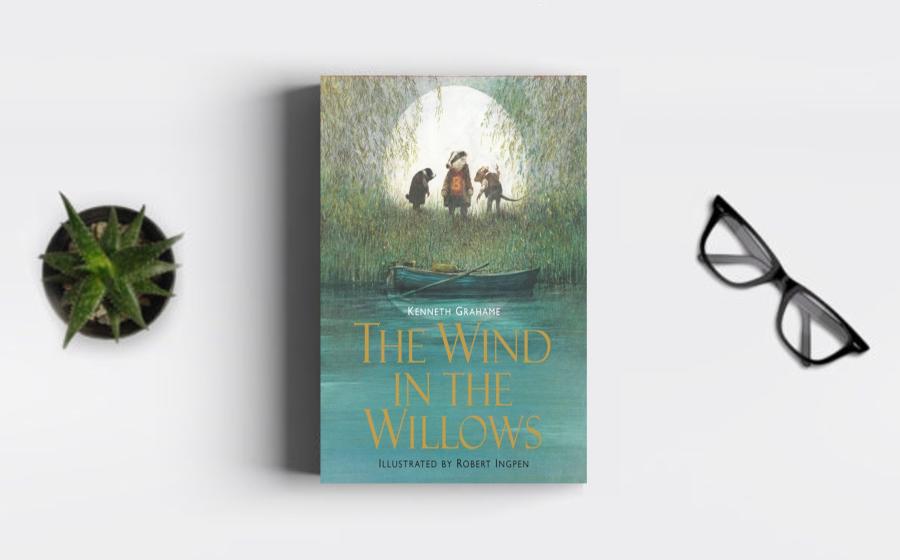"The Wind in the Willows," written by Kenneth Grahame
and first published in 1908, has earned its status as a
timeless children's classic through its enchanting blend
of whimsical storytelling, endearing characters, and
timeless themes. This captivating tale of friendship,
adventure, and the magic of the English countryside has
continued to capture the hearts of readers young and old
for over a century. As we explore the reasons behind its
enduring appeal, it becomes evident that "The Wind in
the Willows" remains a cherished literary masterpiece
that transcends generations.
At the core of the
book's timelessness is its rich narrative that unfolds
along the serene riverbanks and meadows of the English
countryside. Kenneth Grahame's evocative prose paints a
vivid and enchanting portrait of the natural world,
inviting readers into a landscape where the whimsical
coexists with the ordinary. The author's deep love for
the English countryside is palpable, and his ability to
infuse the setting with a sense of magic and wonder has
contributed significantly to the book's enduring appeal.
The idyllic depiction of the riverside becomes a
sanctuary where readers can escape into a world of
imagination and reconnect with the timeless beauty of
nature.
The endearing characters that populate
"The Wind in the Willows" play a pivotal role in its
timelessness. Mole, Rat, Toad, and Badger have become
iconic figures in children's literature, each with their
distinct personalities and quirks. The relatability of
these characters transcends time, allowing readers of
every generation to connect with the universal themes of
friendship, loyalty, and the joy of simple pleasures.
Mole's sense of wonder, Rat's gentle wisdom, Toad's
exuberance, and Badger's quiet strength create a
tapestry of characters that resonate with readers on a
deeply emotional level. The enduring popularity of these
characters has solidified their place in the hearts of
readers around the world.
The book's exploration
of timeless themes, such as the value of friendship and
the joy of adventure, contributes to its enduring charm.
Grahame weaves a narrative that celebrates the beauty of
genuine companionship and the shared experiences that
strengthen the bonds between friends. The camaraderie
between Mole, Rat, Toad, and Badger serves as a
testament to the enduring power of friendship, reminding
readers of the importance of connection and mutual
support. The book's celebration of the simple joys of
life picnics by the river, leisurely boat rides, and
shared laughter resonates across generations, offering a
timeless reminder of the treasures found in everyday
moments.
The narrative's exploration of adventure
and the thrill of discovery adds an element of
excitement that appeals to readers of all ages. From
Toad's wild escapades and daring exploits to the
explorations along the riverbank, "The Wind in the
Willows" captures the essence of childhood wonder and
the timeless allure of the unknown. The book's ability
to transport readers into a world of fantastical
adventures and daring pursuits allows it to transcend
the confines of time, offering a sense of exhilaration
that remains undiminished through the years.
The
underlying sense of nostalgia embedded in the narrative
contributes to the book's timeless quality. Grahame
infuses the story with a wistful longing for the past, a
sentiment that resonates with readers regardless of the
era in which they encounter the book. The idyllic
portrayal of a bygone English countryside, with its
hedgerows, meadows, and cozy riverbank homes, creates a
sense of longing for a simpler time. This nostalgic
thread, woven into the narrative, invites readers to
reflect on their own memories and experiences, fostering
a connection that transcends generational boundaries.
The enduring popularity of "The Wind in the Willows"
is also attributed to its adaptability and continued
relevance in various forms of media. The story has been
adapted into numerous stage plays, films, and television
productions, each interpretation bringing a fresh
perspective to the beloved tale. These adaptations
ensure that the enchanting world of Mole, Rat, Toad, and
Badger remains accessible to new generations of readers,
allowing the timeless magic of the riverside to be
experienced in different artistic expressions.
The book's exploration of themes related to identity and
personal growth adds depth and resonance, making it a
poignant and timeless coming-of-age tale. Toad's journey
from reckless abandon to self-discovery and maturity
resonates with readers navigating the complexities of
growing up. The narrative invites reflection on the
universal themes of responsibility, resilience, and the
transformative power of personal growth. As readers
witness Toad's evolution, they find themselves on a
parallel journey of self-discovery, making "The Wind in
the Willows" a timeless companion for those navigating
the adventure of life.
The book's enduring
relevance is further enhanced by its exploration of
universal human qualities and foibles. Grahame's keen
observations of human nature, depicted through the
animal characters, offer a mirror through which readers
can recognize their own strengths, weaknesses, and
idiosyncrasies. The timeless appeal lies in the
recognition that the characters, despite their animal
forms, embody qualities and characteristics that are
distinctly human. This relatability allows readers to
connect with the narrative on a personal level,
fostering an enduring bond that withstands the test of
time.
The book's enchanting illustrations, most
notably those by E.H. Shepard, contribute significantly
to its timeless charm. Shepard's iconic depictions of
the characters and settings have become inseparable from
the narrative, creating a visual language that enhances
the overall enchantment of the story. The detailed and
whimsical illustrations bring Grahame's world to life,
allowing readers to visually immerse themselves in the
magic of the riverside. The enduring popularity of these
illustrations has played a crucial role in shaping the
visual identity of "The Wind in the Willows."
"The Wind in the Willows" by Kenneth Grahame has secured its place as a timeless children's classic through a combination of enchanting storytelling, memorable characters, universal themes, and enduring visual appeal. The book's ability to transport readers into a world of friendship, adventure, and the magic of the riverside has ensured its continued resonance across generations. Whether experienced as a childhood favorite or discovered anew in adulthood, the story's timeless charm remains undiminished, inviting readers to embark on a journey along the winding riverbanks of imagination where the magic of the willows endures.






